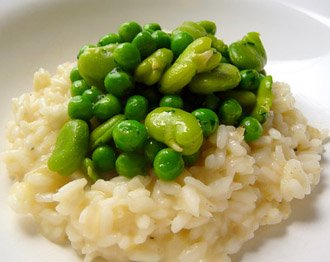Selection and storage
As in green peas, fava too are winter season crops. They can be easily grown in the home garden. Kernels of tender, green pods are preferred as vegetables over fully mature and dry pods. Dry pods, however, may be used as dry beans or split lentils.
Small, very immature pods can be eaten with skin much like green-beans. Usually, however, the pods are shelled, and their seeds are employed in cooking.
In the markets, fresh fava beans can be available from March until June. Canned, frozen, dry, as well as salted and roasted beans are also available in the stores.
While buying, look for fresh, just mature, even shaped, green color beans. Avoid yellow pods as they may indicate overmature, dry, and bitter seeds.
Once at home, place unshelled beans in a perforated plastic bag and store in the refrigerator set at high relative humidity. They stay well for up to a week or so. Use them soon after harvest in order to enjoy their rich natural flavor.
Preparation and serving methods
Fresh broad beans are easy to cook and truly delicious. Gently cooked, tender beans have a wonderful “beany” flavor that melts like butter in
the mouth. Dried beans are generally soaked in water to turn them soft and to remove any bitter anti-nutritional compounds.
To prepare, wash the beans in cold running water. Refrigerated beans need to be dipped briefly in room-temperature water to help them regain their original flavor.
To shell, snap its stem end towards the string side and pull all along the length of the bean to remove the string. Split open and extract the kernels with the help of fingertips and thumb. Drop them into boiling salted water for about 1 minute. Drain water and plunge them into ice water.
Normally, whole broad beans are employed in cooking. You may also remove the husk (thin coat around the bean) to pop out bright green cotyledons (kernels) inside, which are then used in the cooking.
Here are some serving tips:
 |
| Broad beans and peas risotto. Photo courtesy: Blue moon |
-
Broad beans are one of the versatile vegetables. They make delicious recipes in stews, soups, and stir-fries along with
spices, herbs, rice, semolina, peas, carrot, onion, tomato, lamb, poultry, and seafood. -
In North African and Middle Eastern cuisine, boiled couscous (semolina) is served with broad beans and other vegetable stew.
-
Ful medames, an Egyptian mashed fava bean stew topped with parsley, is served with bread for breakfast.
-
Spicy broad bean stews (dip) served with bread, b>beyssara, is a favorite Moroccan breakfast.
-
Dried fava beans lentils used in stew with tomato, onion, and spices is a popular Greek recipe.
Safety profile
Favism is a genetic condition affecting a small population with G-6PD (Glucose-6-phosphate dehydrogenase) enzyme deficiency, compromising oxygen-carrying capacity in their blood. The condition is triggered in these individuals by eating fava beans or its products in the diet as well as by some drugs and infections. Prevention mainly includes avoidance of any of these triggering factors and treatment of acute blood cell lysis.
Like other class beans and some Brassica group vegetables, fava too contains oxalic acid, a naturally occurring substance found in some vegetables, which, may crystallize as oxalate stones in the urinary tract in some people.
Therefore, people with known oxalate urinary tract stones are advised against eating vegetables belonging to the Brassica and Fabaceae family. Adequate intake of water is therefore encouraged to maintain normal urine output to minimize the stone risk. (Medical disclaimer).
Also read ≻≻-
≻≻-Adzuki beans nutrition facts and health benefits.
≻≻-Lima beans nutrition facts and health benefits.
≻≻-Back to Vegetables from Fava beans. Visit here for an impressive list of vegetables with complete illustrations of their nutrition facts and
health benefits.
≻≻-Back to Home page.
Further reading:
-
Stanford School of Medicine Cancer information Page- Nutrition to Reduce Cancer Risk.
-
USDA National Nutrient database.

